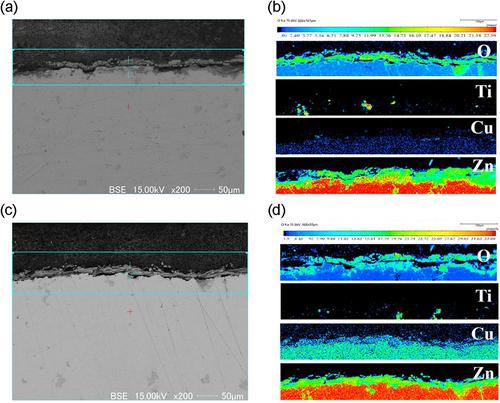当前位置:
X-MOL 学术
›
Mater. Corros.
›
论文详情
Our official English website, www.x-mol.net, welcomes your
feedback! (Note: you will need to create a separate account there.)
Enhanced corrosion resistance of Zn–Cu–Ti alloy with addition of Cu–Ti amorphous ribbons in 3.5% NaCl solution
Materials and Corrosion ( IF 1.6 ) Pub Date : 2021-02-08 , DOI: 10.1002/maco.202012159 Ya Ni 1 , Guoguang Wu 1
Materials and Corrosion ( IF 1.6 ) Pub Date : 2021-02-08 , DOI: 10.1002/maco.202012159 Ya Ni 1 , Guoguang Wu 1
Affiliation

|
In the present study, Zn–0.3Cu–0.3Ti alloy (sample I) was fabricated by a simple low-temperature melting method using Cu–50Ti amorphous alloy ribbons for corrosion in 3.5% NaCl solution. As a comparison, crystalline Cu–50Ti master alloy was used to prepare Zn–0.3Cu–0.3Ti alloy (sample II). Sample I comprising Zn, TiZn3, and TiZn15 phases exhibits an equiaxed microstructure with subgrain structure. Large TiZn3 particles show cluster feature, whereas intermittent small TiZn15 particles exist at grain boundaries and subgrain boundaries. In sample II, the Zn matrix with typical dendritic microstructure is observed and no large particles are found. Compared with sample II, sample I shows lower weight gain and corrosion current density and a higher slope of cathode polarization curve. The weight gain for sample I is only 0.59 mg·cm−2, but for sample II, this value reaches 0.70 mg·cm−2. After 8 days of corrosion, corrosion products are mainly Zn5(OH)8Cl·H2O and ZnO, showing loose particle shape. As corrosion time increases from 2 days to 8 days, corrosion layer thickness increases from about 15 to 24 μm for sample 1.
中文翻译:

在 3.5% NaCl 溶液中添加 Cu-Ti 非晶带增强 Zn-Cu-Ti 合金的耐腐蚀性
在本研究中,Zn-0.3Cu-0.3Ti 合金(样品 I)是通过简单的低温熔化方法制造的,使用 Cu-50Ti 非晶合金带在 3.5% NaCl 溶液中腐蚀。作为比较,使用结晶 Cu-50Ti 中间合金制备 Zn-0.3Cu-0.3Ti 合金(样品 II)。包含Zn、TiZn 3和TiZn 15相的样品I表现出具有亚晶粒结构的等轴显微组织。大的 TiZn 3颗粒表现出团簇特征,而间断的小 TiZn 15颗粒存在于晶界和亚晶界。在样品II中,观察到具有典型树枝状微观结构的Zn基体,未发现大颗粒。与样品 II 相比,样品 I 显示出较低的增重和腐蚀电流密度以及较高的阴极极化曲线斜率。样品 I 的增重仅为 0.59 mg·cm -2,但对于样品 II,该值达到 0.70 mg·cm -2。腐蚀8天后,腐蚀产物主要为Zn 5 (OH) 8 Cl·H 2 O和ZnO,呈松散颗粒状。随着腐蚀时间从 2 天增加到 8 天,样品 1 的腐蚀层厚度从大约 15 到 24 μm。
更新日期:2021-02-08
中文翻译:

在 3.5% NaCl 溶液中添加 Cu-Ti 非晶带增强 Zn-Cu-Ti 合金的耐腐蚀性
在本研究中,Zn-0.3Cu-0.3Ti 合金(样品 I)是通过简单的低温熔化方法制造的,使用 Cu-50Ti 非晶合金带在 3.5% NaCl 溶液中腐蚀。作为比较,使用结晶 Cu-50Ti 中间合金制备 Zn-0.3Cu-0.3Ti 合金(样品 II)。包含Zn、TiZn 3和TiZn 15相的样品I表现出具有亚晶粒结构的等轴显微组织。大的 TiZn 3颗粒表现出团簇特征,而间断的小 TiZn 15颗粒存在于晶界和亚晶界。在样品II中,观察到具有典型树枝状微观结构的Zn基体,未发现大颗粒。与样品 II 相比,样品 I 显示出较低的增重和腐蚀电流密度以及较高的阴极极化曲线斜率。样品 I 的增重仅为 0.59 mg·cm -2,但对于样品 II,该值达到 0.70 mg·cm -2。腐蚀8天后,腐蚀产物主要为Zn 5 (OH) 8 Cl·H 2 O和ZnO,呈松散颗粒状。随着腐蚀时间从 2 天增加到 8 天,样品 1 的腐蚀层厚度从大约 15 到 24 μm。











































 京公网安备 11010802027423号
京公网安备 11010802027423号